by Sihui Huang
The Decorator Design Pattern is kind of like a waffle
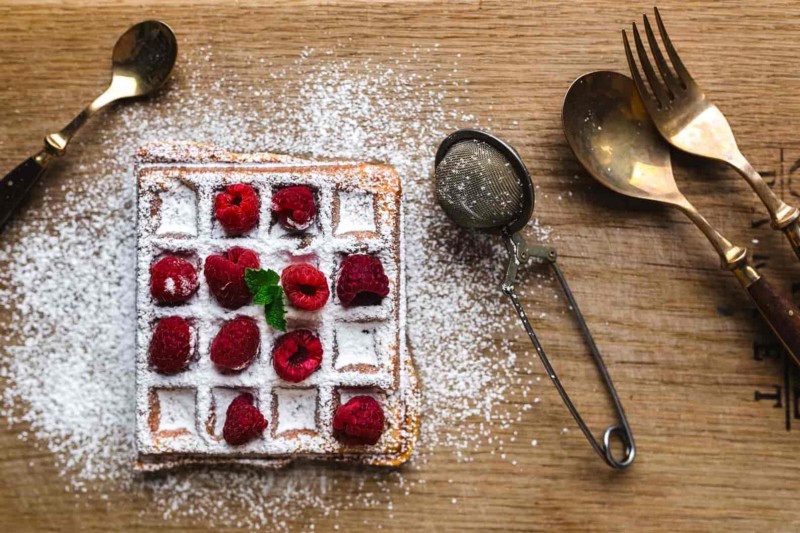
The decorator pattern is about adding extra features to an existing object.
Does that sound like French?
No worries.
We will come back to this later.
Let’s take a look at some waffles first!
The genius part about waffles is that they start plain and simple. Because they are plain, almost everything tastes good with them
Some common toppings for waffles are strawberries, blueberries, blackberries, bananas, almonds, and syrups.
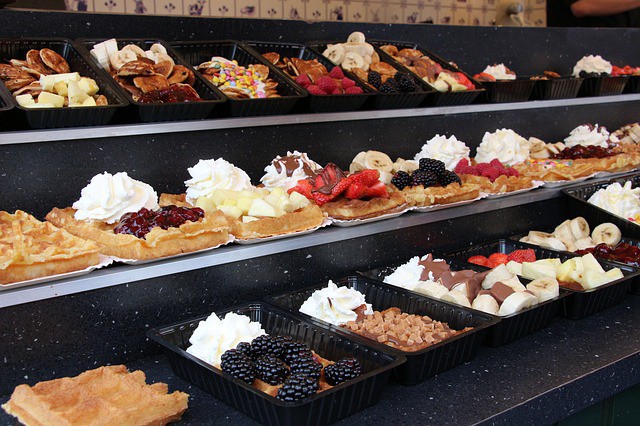
Let’s try to create a collection of different waffle objects.
There will be StrawberryWaffle, BlueberryWaffle, BlackberryWaffle, BananaWaffle, AlmondWaffle, and SyrupWaffle.
Wait, we can have strawberries and blueberries on the same waffle. This gives us a StrawberryBlueberryWaffle.
We can also have strawberries and blackberries on the same waffle. This gives us a StrawberryBlackberryWaffle.
No one is forbidding us from putting three toppings on the same waffle. This gives us a StrawberryBlueberryBlackberryWaffle.
To make things simple, let’s consider strawberries, blueberries, and blackberries as potential toppings. There are eight different combinations[1].
Does this mean we need to create eight different objects for our waffle collection?
If we add bananas into our potential toppings list, there are 16 different combinations[2].
It’s obvious that adding a single topping to our toppings list causes an explosion in our waffle collection.
It’s not feasible to create a different waffle class for each possible combination of toppings. There must be a better way to do this.
What if, when we want a StrawberryWaffle instead of creating a StrawberryWaffle, we create a Waffle and add strawberries to it?
What about StrawberryBlueberryWaffle then? ???
???We can create a Waffle, add strawberries to it, and add blueberries to it!???
Creating Waffle Classes
Let’s take a look at the plain waffle class:
You can create a waffle, serve it, and eat it like this:

And here is the StrawberryWaffle class:
Notice we pass a waffle object inside the StrawberryWaffle constructor to create a StrawberryWaffle.
The StrawberryWaffle class has:
- The passed-in waffle
- Strawberries as a topping
- A
servemethod that calls the passed-in waffle’sservemethod. Then printstopped with strawberries - A
eatmethod that calls the passed-in waffle’seatmethod and then printsand then eat some strawberries
You can create a strawberry waffle, serve it, and eat it like this:

Here are the BlueberryWaffle and BlackberryWaffle classes:
And you can use them like this:
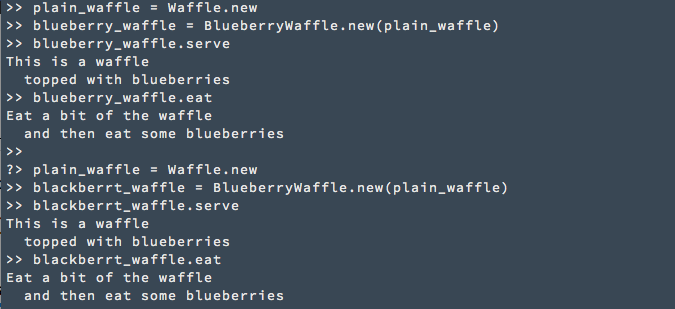
Pulling the Common Part Out
Noticing the StrawberryWaffle class, the BlueberryWaffle class, and the BlackberryWaffle class are almost identical except for their topping, we can pull the common parts out as a parent class.
In WaffleDecorator, topping is no longer an attribute of the object. Instead, it’s a method that can be overridden by a child class.
Now we can rewrite StrawberryWaffle, BlueberryWaffle, and BlackberryWaffle to inherit WaffleDecorator to gain these common functionalities:
And they should still work the same as before:
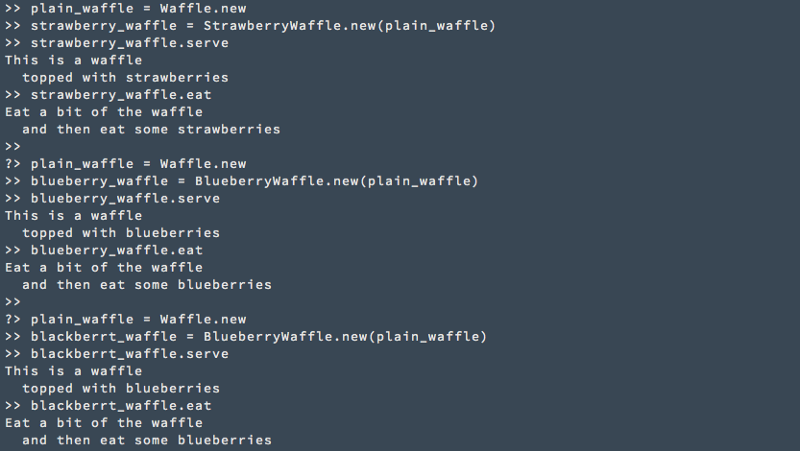
Here are the classes we create:
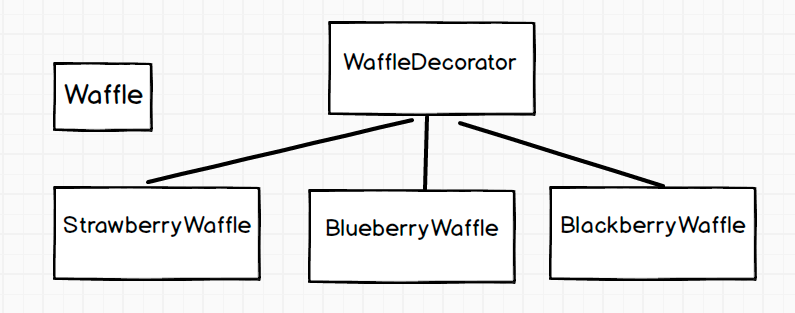
Creating a BlueberryStrawberry Waffle
Now we have Waffle, StrawberryWaffle, BlueberryWaffle, and BlackberryWaffle.
It’s time to achieve the goal we originally set out:
create a Waffle, add strawberries to it, and add blueberries to it.
Just like this:

And we can:
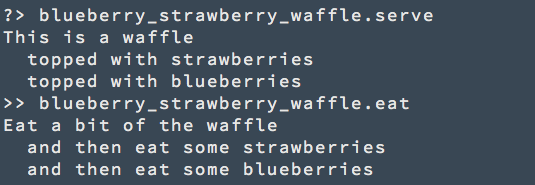
What is happening?! ???
Let’s take a closer look at how we created the blueberry_strawberry_waffle:
First, we created a plain_waffle with Waffle: plain_waffle = Waffle.new
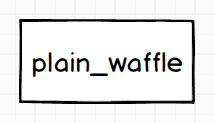
Then we created strawberry_waffle by passing the plain_waffle into the StrawberryWaffle constructor. strawberry_waffle = StrawberryWaffle.new(plain_waffle)

It’s worth noting that when we create the strawberry_waffle, we hold the passed-in plain_waffle as an instance variable of strawberry_waffle:

As we can see, strawberry_waffle.waffle and plain_waffle are the same object:

At this point, when we call strawberry_waffle.serve. We first call plain_waffle.serve then print topped with strawberries.


For strawberry_waffle.eat, we first call plain_waffle.eat then print and then eat some strawberries.
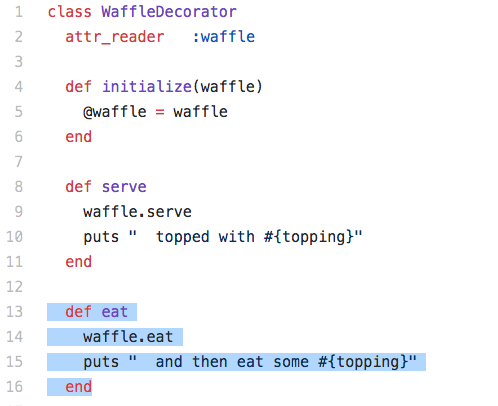

We create blueberry_strawberry_waffle by passing the strawberry_waffleinto the BlueberryWaffle constructor. blueberry_strawberry_waffle = BlueberryStrawberryWaffle.new(strawberry_waffle)
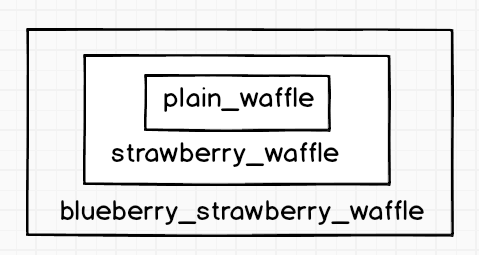
When we create the blueberry_strawberry_waffle, we hold the passed-in strawberry_waffle as an instance variable of blueberry_strawberry_waffle:

When we call blueberry_strawberry_waffle.serve we first call strawberry_waffle.serve. Which calls plain_waffle.serve then prints topped with strawberries. Then print topped with blueberries.

When we call blueberry_strawberry_waffle.eat we first call strawberry_waffle.eat. Which calls plain_waffle.eat then prints and then eat some strawberries. Then print and then eat some blueberries.

The Key of the Magic:
strawberry_waffle is built on top of plain_waffle. And blueberry_strawberry_waffle is built on top of strawberry_waffle.
The key of being able to build waffles on top of each other is all waffles have to obey the same interface.
All waffles have a serve method and an eat method.
That’s why within the StrawberryWaffle/BlueberryWaffle/BlackberryWaffleclasses, we are confident that the passed-in waffle has a serve method and an eat method.
And we can leverage the serve method and the eat method from the passed-in waffle when defining a new serve method and a new eat method.
A WaffleDecorator doesn’t care about the kind of waffle. It can be a plain_waffle, a strawberry_waffle, or an alien-waffle.
All that matters is that a WaffleDecorator takes a waffle and returns a enhanced waffle. The waffle it takes and the waffle it returns obey the same interface.
Since all decorators taking and returning waffles obey the same interface, the result of a decorator can be passed into another decorator.
Just like this:

or this:

Now with Waffle, StrawberryWaffle, BlueberryWaffle, and BlackberryWaffle, we can create all eight different waffles.
Adding banana into our topping list is as easy as:

You just Learned the Decorator Pattern! ???
Here’s its definition:
Decorator attaches additional responsibilities to an object dynamically.
Takeaways:
- The decorator pattern is about adding additional features to an existing object easily.
- The object to be decorated (the one being passed into all decorators) and objects returned from decorators have to obey the same interface.
Thanks for reading! I hope you enjoy the article. ?
I publish to sihui.io weekly.
Subscribe so you won’t miss the next article from the series.
Next time we will take a look at …

[1] PlainWaffle, StrawberryWaffle, BlueberryWaffle, BlackberryWaffle, StrawberryBlueberryWaffle, StrawberryBlackberryWaffle, BlueberryBlackberryWaffle, and StrawberryBlueberryBlackberryWaffle.